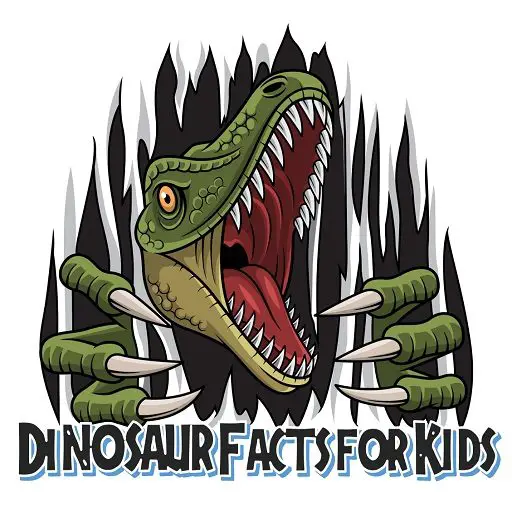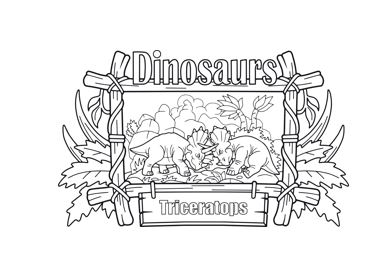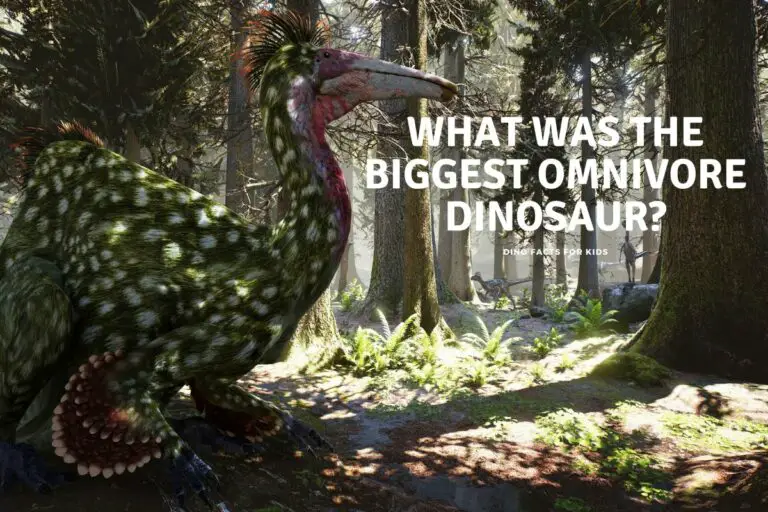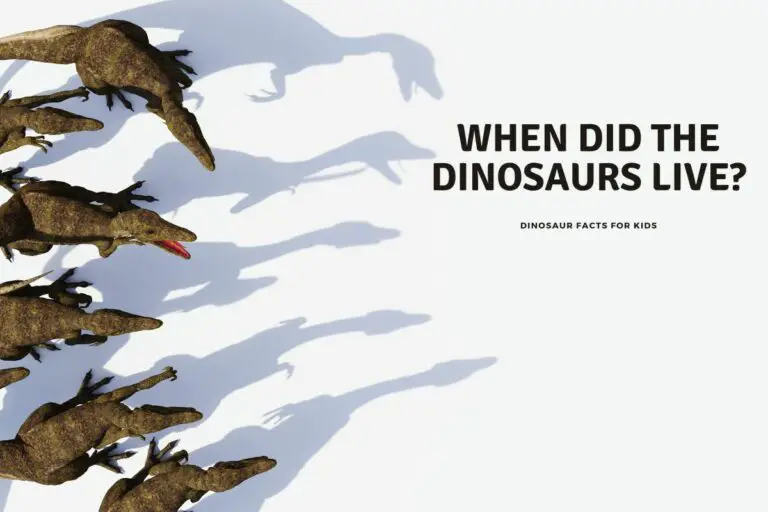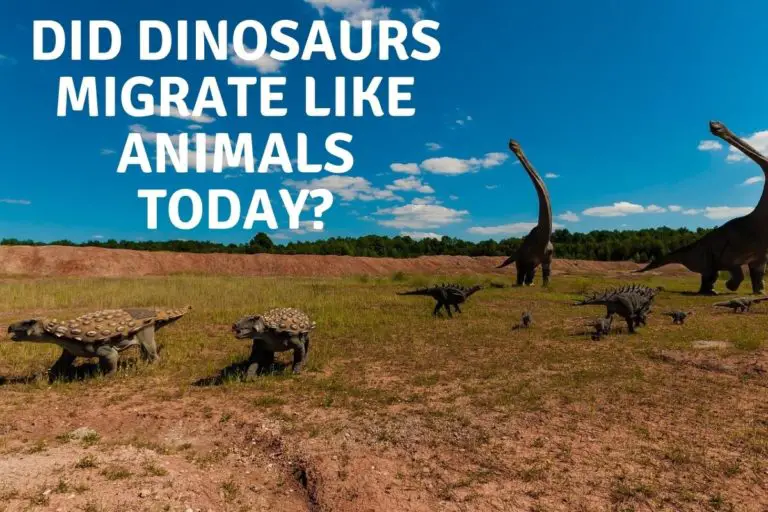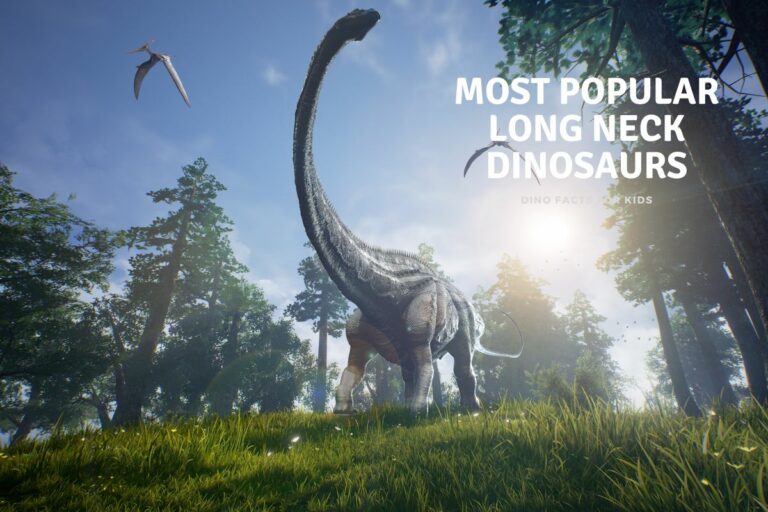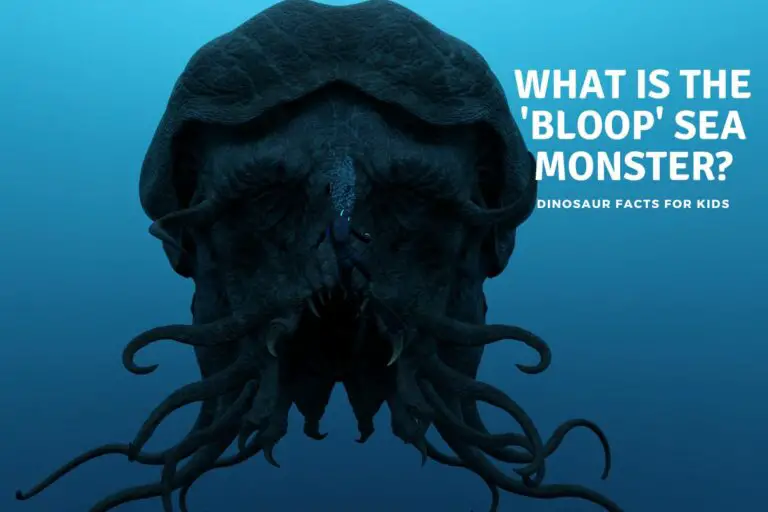What Were The Largest Horned Dinosaurs?
If you think of a horned dinosaur, you probably think of a Triceratops. While the Triceratops has been popularized as one of the only horned dinosaurs, this isn’t true! These dinosaurs had plenty of horned cousins that had unique and distinguishing characteristics.
The largest horned dinosaurs included the Eotriceratops Xerinsularis, Triceratops, Pentaceratops, Styracosaurus, and Sinoceratops. These dinosaurs fall into the classification of ceratopsians, which grouped dinosaurs with bony frills and an upper beak to break off plants. Ceratopsians were herbivorous.
So, if you want to brush up on your dinosaur knowledge, or you’re just interested in knowing a bit more about our prehistoric history, you’re in luck. We’ve got everything you need to know about the largest horned dinosaurs to walk the earth, also known as the ceratopsian dinosaurs which means “horned faces”
Sometimes it’s hard to understand how heavy, how big , how long these horned dinosaurs could be for us small humans. so we have a little key with measurements from pounds to a car, feet of a school bus, height of a an average person to give you an idea when you see how big these horned dinosaurs could grow!
Key to understand the size of dinosaurs:
- School bus – 30 feet long.
- Four door car – 3000 lbs
- Height of a person – 6 ft tall.
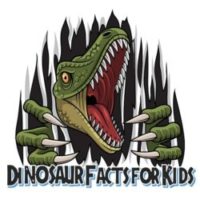
What are the Horned Dinosaurs
Horned dinosaurs are also known by their scientific name of Certopisan which means horned face. Although not all of the members of the ceratopsian family have horns most do of some description.
They are also mostly larger dinosaurs with the largest being over 30 ft long and 20,000 lbs! They are easy to identify as they often have large head and neck frills with bumps and spikes around the edges in addition to their horns, they also have hooked hard beaks to eat plants and vegetation with. Most but not all walk on four legs.
What were the largest Horned Dinosaurs
1. Eotriceratops
(Dawn Three Horn face)
You were probably expecting to find Triceratops at the top of this list. However, The Eotriceratops may often be confused with the Triceratops due to their almost identical appearance. Eotriceratops, however, was much larger and had straighter facial horns.
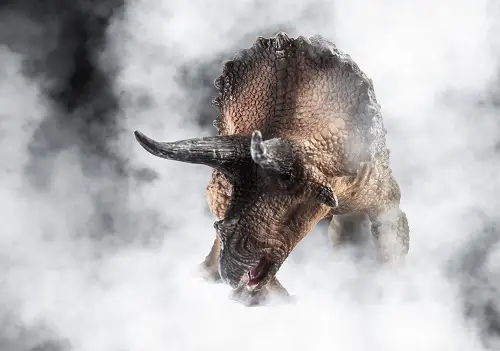
With three straight horns on their heads, these dinosaurs used their horns to scare away predators. As herbivorous dinosaurs, Eotriceratops were under constant threat from carnivorous predators.
| Dinosaur | Weight in Pounds | Height in Feet | Length In feet | Number of Horns | Period Alive. |
| Eotriceratops Xerinsularis | 22000 lbs | 11.8 ft | 29-33 feet | 3 | Late Cretaceous |
In addition to being social animals, Eotriceratops lived in large herds to better protect themselves and their offspring from predators. Although they may have been able to put up a fight thanks to their horns, these dinosaurs weren’t able to move very quickly to run away from danger due to their short and heavy bodies.
These hefty ceratopsians weighed around 11 tons, making them slow and docile creatures.
With only one specimen found to date, paleontologists estimate that Eotriceratops were between 29 and 33 feet long. This specimen’s skull alone measured a whopping 9.8 feet.
How to pronounce Eotriceratops:
“ Ee -Oh – Try – Sair – Rah – Tops”
2. Triceratops
(Three Horn Face)
Another 3-horned dinosaur, the Triceratops, had a massive body and enormous frill around its head that acted as protection against apex predators and a means for males to attract possible mates.
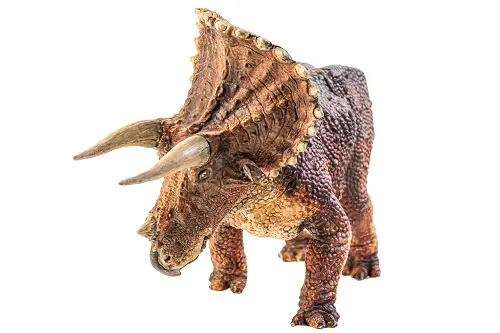
Slightly smaller than the Eotriceratops, these dinosaurs had an average weight of 10 tons and measured around 30 feet long. They were also approximately 10 feet tall, with horns that could reach up to 4 feet in length.
| Dinosaur | Weight in Pounds | Height in Feet | Length In feet | Number of Horns | Period Alive. |
| triceratops | 20000 lbs | 10.5 ft | 30 feet | 3 | Late Cretaceous |
While their horns may seem big, they were only around half the size of the Triceratops skull, which could be as large as 8.2 feet!
Triceratops horridus and Triceratops prorsus are the only two known Triceratops species. They are distinguishable from one other by the size of their horns and beaks.
Triceratops fossils are some of the most common fossils unearthed to date.
Judging by the remains we have found, we know that these herbivorous dinosaurs had specialized teeth. They used their teeth to grind harder plants and sharp beaks to help them break them off during grazing.
We also have a dedicated page on how large a triceratops was here on the site.
How to pronounce Triceratops:
“ Try – Sair – Rah – Tops”
3. Pentaceratops
(Five Horned face)
Even though Pentaceratops is one of the more recognizable ceratopsians, some people still believe this dinosaur had five horns due to the meaning of its name. While it shares the exact horn placement as the Eotriceratops and Triceratops, the Pentaceratops also have sharp cheekbones that are considered horns.
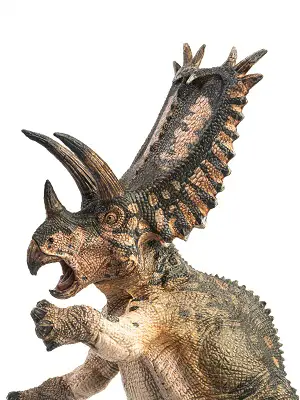
At around 17 feet tall, these dinosaurs were even taller than their look-alikes. But, when you take a closer look at their length and weight, it’s evident that they were, in fact, much shorter and lighter.
| Dinosaur | Weight in Pounds | Height in Feet | Length In feet | Number of Horns | Period Alive. |
| Pentaceratops | 9-11000 lbs | 10.5 ft to the frill top – 7-8 feet to top of back. | 19 -26 feet | 3 facial horns 2 horned cheekbones | Late Cretaceous |
Pentaceratops was roughly 19 to 26 feet long, weighing in at the proportionally low weight of only 4.4 to 5.5 tons.
Like many other horned dinosaurs, Pentaceratops had a hooked beak that they used to clip plant leaves. Pentaceratops were also known for their large and extravagant protective crest-shields, which were evolved to guard against and discourage predators and mating and courting rituals.
How to pronounce Pentaceratops:
“ Pen – tah – Sair – Rah – Tops”
4. Pachyrhinosaurus
(Thick Nose Lizard)
Pachyrhinosaurins was a large horned dinosaur that lived among other ceratopsian dinosaurs like Triceratops, It was found in 1946, but named 4 years later in 1950 and was in a fossil bed on Alberta in Canada.
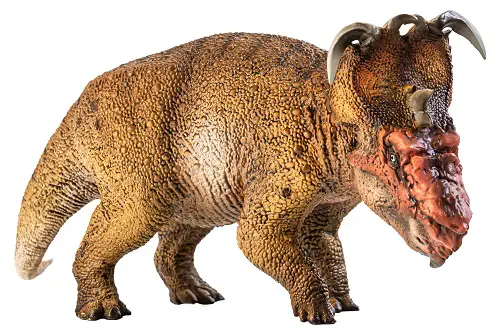
it was a large dinosaur, although not the biggest horned dinosaur, which goes to Eotriceratops. it didn’t actually have horns on the face despite being part of the horn face family, they had bumps on their noses and over their eyes instead.
Though they did have two curved horns on their frills that looked like they could do some damage. The could be up to 8000 lbs in weight, that’s more than two cars! and the length of a school bus!
| Dinosaur | Weight in Pounds | Height in Feet | Length In feet | Number of Horns | Period Alive. |
| Pachyrhinosaurus | 8,000 lbs | 8 feet tall to the Frill. | 19 -26ft | It had bony bumps. on its face. It had two horns on its Frill. | Late Cretaceous |
they may not have had the horns of other horned “ceratopisan” dinsaours but they did have the beak shaped mouth to eat planets with.
How to pronounce Pachyrhinosaurus:
“ Patch – ee – Rhy – No – Sore – Rus”
5. Styracosaurus
(Spiked Lizard)
You may have mistakenly identified a Styracosaurus before, and we don’t blame you! But, upon closer inspection of this horned dinosaur, it would become increasingly apparent that they have striking differences. These differences set them apart from their well-known cousin, the Triceratops.
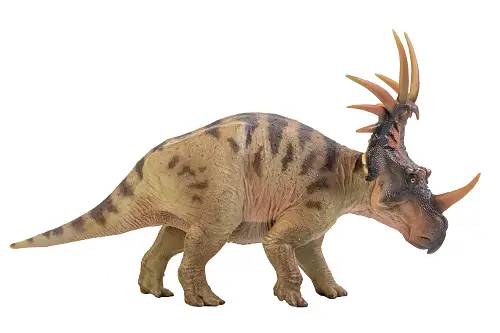
The most obvious difference, of course, is that, unlike the Triceratops, this dinosaur only has one horn. This horn can be found on their nose and is much longer than that of a Triceratops, reaching up to 2 feet in length.and it had spikes along its frill
| Dinosaur | Weight in Pounds | Height in Feet | Length In feet | Number of Horns | Period Alive. |
Styracosaurus | 6000 lbs | 6.5 -7 ft | 18 ft | 1 but spiked frill on neck. a Vicious looking one! | Late Cretaceous |
Styracosaurus was a powerful dinosaur that grew around 18 feet long and weighed approximately 3 tons. It was about 6 feet tall and had a big body, four stumpy legs, and a small tail.
This dinosaur, like other ceratopsians, may have been a social dinosaur that traveled in large numbers, as evidenced by several bonebeds with multiple Styracosaurus fossils.
How to pronounce Styracosaurus:
“ Sty – Rack – Uh – Sore – Rus”
6. Centrosaurus
(Pointed Lizard)
Centrosaurus was another dinosaur discovered in Alberta, which has provided a lot of horned dinosaur fossils over the years. It was a medium sized dinosaur with a single horn, pretty large at 2ft long above its nose considering its whole body was much shorter than a triceratops.
Like other horned dinosaurs it had a frill that was too thin to protect its neck from attack and it was shorter than other members of the horned dinosaur family. The Frill also had horns and there were another pair of small horns just above the eyes as well.
| Dinosaur | Weight in Pounds | Height in Feet | Length In feet | Number of Horns | Period Alive. |
Centrosaurus | 5-6000 lbs | 6.5 -7ft | 18 ft | 1 large and 2 smaller horns over the eyes | Late Cretaceous |
There have been huge bone beds found of centrosaurus found in canada, which is a good suggestion that they moved together in herds and these bones beds also hold Styracosaurus fossils which further suggests that they were replaced by these dinosaurs over time.
How to pronounce Centrosaurus:
“ Sen – Trow – Sore – Rus
7. Sinoceratops
(Chinese Horned Face)
The Sinoceratops have a distinct look that sets them apart from some other ceratopsians on this list.
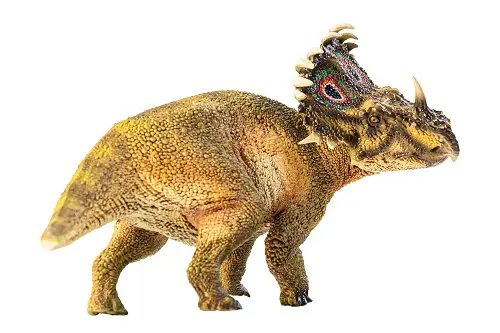
It has a nasal horn that is small and curved and a short neck frill with several curved hornlets. These hornlets give the Sinoceratops the appearance of wearing a crown.
| Dinosaur | Weight in Pounds | Height in Feet | Length In feet | Number of Horns | Period Alive. |
Sinoceratops | 4500 lbs | 6. ft | 20 ft | 1 nasal horn Multiple frill hornlets | Late Cretaceous |
There are also several nodules that sit on the inside of their frill, just below their crown, which hasn’t been observed in any other horned dinosaur up to this point.
Sinoceratops is especially noteworthy because it is one of the biggest recorded centrosaurines, (spiked horns) dwarfing all other known group members. But that doesn’t mean that they were bigger than some of the other horned dinosaurs discovered.
Sinoceratops was a ground-dwelling, quadrupedal herbivore of medium size and average build. These dinosaurs could reach a length of around 20 feet, a height of 6.6 feet, and a weight of 2.2 tons. Compared to other dinosaurs on this list, it may even be considered relatively small.
How to pronounce Sinoceratops:
“ Sign – Oh – Sair – Ah – Tops “
8. Chasmosaurus
(Opening Lizard)
A very easily recognizable medium sized horned dinosaur the chasmosaurus is famous for its huge neck frill more than its horns. though it did have three horns on its face of a fairly equal, if short, size.
However the frill was longer and unlike other horned dinosaurs it had holes in the bony plate which were triangle, kind of, in shape.
| Dinosaur | Weight in Pounds | Height in Feet | Length In feet | Number of Horns | Period Alive. |
Chasmosaurus | 3-5,000 lbs | 6.5 ft | 14-16 feet | 3 horns, and tall frill | Late Cretaceous |
It was a medium sized dinosaur that weighed between 3-5,000 lbs, and was about half the length a school bus. it was actually quite bulky a dinosaur for its length.
How to pronounce Chasmosaurus:
“ Kaz – Mo – Sore – Rus
9. Nasutoceratops
(Large Nosed Horned Face)
Nasutoceratops is a less well known member of the horned dinosaur family which may become more famous after its upcoming movie debut in Jurassic World Dominion. You can see it already in the prologue on YouTube.
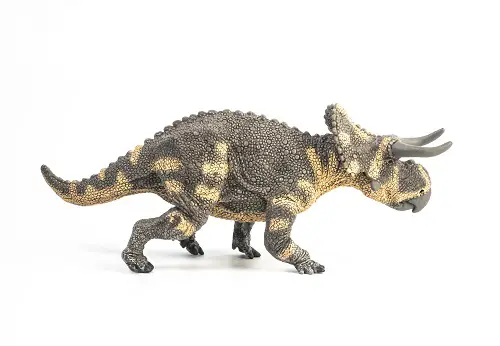
Nasutoceratops had a 5 ft long skull that had two long horns that have been compared to cattle horns, except longer. its frill have spikes and notches around the outside. It was a smaller horned dinosaur about 15 feet long or half a school bus and abotu 6ft tall.
| Dinosaur | Weight in Pounds | Height in Feet | Length In feet | Number of Horns | Period Alive. |
Nasutoceratops | 3000 lbs | 6 ft | 15 feet | 2 horns, and tall frill | Late Cretaceous |
How to pronounce Nasutoceratops
“ Nay – suh – Tuh – Sair – Ra – Tops
10. Gryphoceratops the Smallest Horned Dinosaur.
(Griffon – Horned – Face)
Just as a demonstration that not all things dinosaur have to be oversized like the top of this list there are dinosaurs at the other end of the size scale as well. This is where you will find this little horned dinosaur called Gryphoceratops, It was tiny by any scale, about the size of a house cat and measured only 1.6 feet (0.5 meters) long. At that size it couldn’t have weighed more than 20lbs, and probably less.
| Dinosaur | Weight in Pounds | Height in Feet | Length In feet | Number of Horns | Period Alive. |
Gryphoceratops | 15 lbs – estimate | 1 ft | 1.6 feet | none | Late Cretaceous |
it lived about 83 million years ago, and unlike its bigger family members had no real defences to speak of to protect it from predators, which 83 million years ago would have been quite a few well armed dinosaurs!
Gryphoceratops was a herbivore, and the beak like mouth ( like other ceratopsian) dinosaurs reminded the scientists who named it of the mythical griffon. Hence the name! Currently this is the smallest horned dinosaur found. (despite its lack of horns)
How to pronounce Gryphoceratops:
“ Griff – oh – sair – Rah – Tops”
Largest Horned Dinosaur Comparison
While many of the horned dinosaurs on our list are close in length, their weights could vary considerably. It’s also interesting to note that all of these ceratopsians roamed the earth during the Late Cretaceous period, meaning that these types of dinosaurs were more prevalent during this time.
| Dinosaur | Weight (pounds) | Height (in feet) | Length (feet) | Number of horns | Period |
| Eotriceratops Xerinsularis | 22000 lbs | 11.8 ft | 29 – 33 | 3 | Late Cretaceous |
| Triceratops | 20,000lbs | 10.5 ft | 30 feet | 3 | Late Cretaceous |
| Pentaceratops | 9-11,000 lbs | 10.5 ft to the frill top – 7-8 feet to top of back. | 19 – 26 | 3 facial horns 2 horned cheekbones | Late Cretaceous |
| Pachyrhinosaurus | 8,000 lbs | 8 feet tall to the Frill. | 19 -26ft | It had bony bumps. on its face. It had two horns on its Frill. | Late Cretaceous |
| Styracosaurus | 6000 lbs | 6.5 -7 ft | 18 | 1 but spiked frill on neck. a Vicious looking one! | Late Cretaceous |
| Centrosaurus | 5-6000 lbs | 6.5 -7ft | 18 ft | 1 large and 2 smaller horns over the eyes | Late Cretaceous |
| Sinoceratops | 4500 lbs | 6 ft | 20 ft | 1 nasal horn Multiple frill hornlets | Late Cretaceous |
| Chasmosaurus | 3-5,000 lbs | 6.5 ft | 14-16 feet | 3 horns, and tall frill | Late Cretaceous |
| Nasutoceratops | 3000 lbs | 6 ft | 15 feet | 2 horns, and tall frill | Late Cretaceous |
| Gryphoceratops | 15 Lbs | 1 ft | 1.6 feet | none | Late Cretaceous |
Horned Dinosaur Coloring pages
We have a selection of both individual horned dinosaur coloring pages and a set of horned dinosaur coloring pages for you to download. they are printable and free!
You can check out the pages on each dinosaur for the free Fact sheet to download and collect as well! We have the large horned dinosaurs like triceratops, Pentaceratops, Nasutoceratops and more coloring pages here. Just scroll down to the sections 🙂
We also have an article on the friendliest dinosaurs as well, if you wanted to check it out.
If you are looking for the smallest dinosaurs ever to live then we have this article here on the site as well.
Conclusion
So while the Eotriceratops is the largest horned dinosaur, or ceratopsian dinosaur there really is not much in it. The top three largest horned dinosaurs are all the length of a school bus and the weight of about 7-8 medium sized cars. Making them huge dinosaurs.
However for as many large horned dinosaurs there were there were also plenty of smaller horned dinosaurs as well and with the gryphoceratops we gave an example of how very small they could be.
Don’t forget to check out our facts sheets, information and more on all dinosaurs. Just click the big button below.
References
- https://en.wikipedia.org/wiki/Eotriceratops
- https://en.wikipedia.org/wiki/Triceratops
- https://en.wikipedia.org/wiki/Pentaceratops
- https://en.wikipedia.org/wiki/Styracosaurus
- https://en.wikipedia.org/wiki/Sinoceratops
- https://www.nbcnews.com/id/wbna46761107
Hi, I am Roy Ford a General Studies and English Teacher who has taught all over the world. What started as a fossil collection became a great way to teach, motivate and inspire students of all ages and all over the world about dinosaurs and from that and children’s love of dinosaurs came the site dinosaur facts for kids, a resource for all ages.
